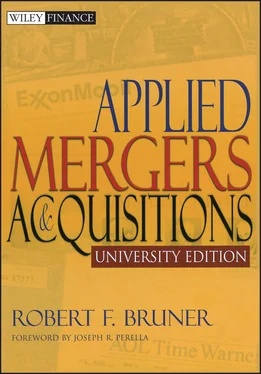SOME CAVEATS ABOUT THE POPULAR SELF-SUSTAINABLE GROWTH MODEL OF ASSETS
In the hands of an artful analyst, the popular model can yield valuable insights. But it can be abused and misused easily. Financial executives and their advisers should beware of six potential problems:
1 The model says nothing about value creation. The popular model describes the maximum growth rate in assets, not market value. All too often, financial advisers take for granted the wisdom of stated growth targets—but such growth targets are usually stated in terms of sales or assets and may be realizable only with the destruction of market value of equity and/or debt. The model should not be used without some complementary analysis proving the economic attractiveness of the growth goals. A much more detailed analysis of self-sustainable growth and its sources may be gained from a forecast of financial statements, or cash receipts and disbursements. The self-sustainable growth model is nothing more than a summary of such a forecast. This detailed model could be prepared as a computer spreadsheet with various operating and financial policy variables as assumptions or outputs, depending on whether the objective is to determine growth-sustaining policies or merely to compute the cash flow and time-value-adjusted self-sustainable growth rate.
2 The popular model is an accrual-accounting-based, one-year measure. ROE and ROTC are measured over one year, typically from historical performance. Can this performance be sustained over the long term into the future? Moreover, by focusing on reported earnings, the model ignores cash flow items such as deferred taxes, which might be the basis for much higher self-sustainable growth.
3 The popular model assumes fixed assets grow at the rate of sales. This would be inappropriate for firms whose fixed asset additions are large, lumpy, and intermittent. Also, firms that have spare productive capacity may not need to add assets in a particular year.
4 The popular model estimates the nominal self-sustainable growth rate; yet it is the real self-sustainable growth rate that is of strategic interest. Under inflation, the real growth rate will be smaller than the nominal rate, and indeed, could even be negative even though the nominal rate is large and positive. Roughly speaking, the real self-sustainable rate will be equal to the difference between the nominal self-sustainable rate and the rate of inflation.
5 The self-sustainable growth rate is no panacea. Rarely are the remedies indicated by the model easy to implement. This is because many of the variables in the model are exogenous to the firm: (1) interest rates are set in the capital markets; (2) product and factor prices are determined by competitive conditions; (3) internal programs to cut costs may be limited by managerial talent; and so on.
6 The assumption of only internal equity financing violates a basic premise of modern finance theory. The premise is that capital is always accessible to firms having profitable investment opportunities. Indeed, from a macroeconomic point of view, society should want managers to fund all profitable opportunities. Why managers choose to constrain their own growth is not well understood, though many of the reasons suggested at the opening of this note probably explain why: concerns about control, confidentiality, transaction costs, and so on. In any event, the fact is that the American business economy relies very little on equity financing: From 1950 to 1990, only 4 percent of all capital investment was financed by the sales of new equity. In short, even though equity capital is always accessible, most executives make little use of it.
1 1. Oxford English Dictionary, 2nd ed., Oxford: Oxford University Press, 1998, Vol. 16, page 852.
2 2. For a more detailed discussion of the growth-share matrix in strategic planning, see Hax and Majluf (1984), Chapter 7.
3 3. SIC stands for “Standard Industrial Classification.” The U.S. Commerce Department’s classification of firms in an industry should be checked for reasonableness.
4 4. This financial rationale for conglomerate mergers presupposes that shareholders are unable to replicate this through their own investing and homemade leverage. Taxes, transaction costs, margin requirements, and high consumer loan rates can frustrate the individual investor’s attempt to synthesis this benefit.
5 5. Financial recapitalizations may also affect the operations and asset mix of the firm. These deals are often predicated on asset sales, plant closings, spin-offs, and so on.
6 6. To “divisionalize” is to adopt an organizational structure for the firm that shapes major segments or divisions around product groups.
7 7. See Weston (1970), Chandler (1977), Alchian (1969), and Williamson (1975).
8 8. See Morck, Schleifer, and Vishny (1990), Sicherman and Pettway (1987), Morck (1990), Maqueira et al. (1998), Nail, Megginson, and Maqueira (1998), Delong (2001), and Megginson, Morgan, and Nail (2002).
9 9. See Carow (2001), Hubbard and Palia (1999), Schipper and Thompson (1983), Elgers and Clark (1980), Matsusaka (1993), and Ferris et al. (2002).
10 10. See Berger and Ofek (1995, 1999), Lang and Stulz (1994), Servaes (1996), Comment and Jarrell (1995), Lins and Servaes (1999), Mansi and Reeb (2002), Denis, Denis, and Yost (2002), and Lamont and Polk (2002).
11 11. Berger and Ofek (1995) compute the diversification discount as excess value divided by the imputed value of the firm. The actual value is the market value of equity plus the book value of liabilities. The imputed value is the sum of segment values estimated by the product of a valuation multiple for single-business peers (total capital divided by assets, sales, or operating earnings) times the accounting value for the segment.
12 12. See Chevalier (2000), Hyland and Diltz (2002), Klein (2001), Graham, Lemmon, and Wolf (1998), Campa and Kedia (1999), Villalonga (1999, 2003a), Mansi and Reeb (2002), and Whited (2001).
13 13. See Rumelt (1974, 1982), Ravenscraft and Scherer (1987), and Kaplan and Weisbach (1992).
14 14. See Kruse (2002), Healey, Palepu, and Ruback (1992), Parrino and Harris (1999), and Cornett and Tehranian (1992).
15 15. Amihud and Lev (1991) concluded, “Risk reduction through conglomerate merger may be convincingly rejected on a priori grounds as a merger motive from the stockholders’ point of view.” (Page 615)
16 16. It is easy to grow sales or assets by investing willy-nilly, without attention to value creation. For instance, it is possible for many firms to expand sales by relaxing credit standards and investing in more accounts receivable. But doing so without giving attention to the pricing of that credit or the probability of being repaid can, in the long run, destroy firm value.
17 17. Return on total capital is computed by dividing earnings before interest and after taxes (EBIAT) by the total capital of the firm (i.e., debt plus equity). This is also sometimes called “return on net assets” and is computed as EBIAT divided by net assets (i.e., total assets less current liabilities).
18 18. The dividend payout ratio is computed as dividends divided by earnings.
19 19. The hypothetical bond rating is inferred from Value Line’s rating of financial stability. The after-tax cost of debt is associated with that bond rating as of early 1991.
Конец ознакомительного фрагмента.
Текст предоставлен ООО «ЛитРес».
Прочитайте эту книгу целиком, купив полную легальную версию на ЛитРес.
Читать дальше












